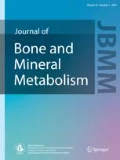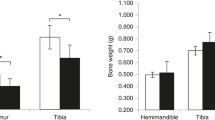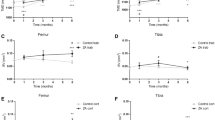Abstract
We evaluated the effects of suppressed bone remodeling caused by bisphosphonate on microdamage accumulation and degree of mineralization of bone (DMB) for the dog rib in two independent studies. Study 1: 36 female beagles, 1-2 years old, were treated daily for 1 year with saline vehicle, risedronate at 0.5 mg/kg/day, or alendronate at 1.0 mg/kg/day. Study 2: 29 beagles, 1 year old, were given lactose, or incadronate at 0.3 mg/kg/day or 0.6 mg/kg/day for 3 years. In both studies, the ninth rib was harvested. Intracortical remodeling was significantly suppressed following either 1 year or 3 years of bisphosphonate treatment without impairment of primary mineralization, although the remodeling rate was obviously lower in study 2 than in study 1 because of the aging of animals. Microdamage accumulation was significantly increased following any bisphosphonate treatment in response to the extent of remodeling suppression. One-year treatment with risedronate or alendronate did not significantly affect the mean DMB or osteonal distribution based on DMB. In contrast, mean DMB was significantly increased following 3 years of incadronate treatments, and osteonal distributions based on DMB showed a dose-dependent shift toward the higher values in incadronate-treated animals when compared with controls. Our results demonstrated that DMB was increased following only 3 years but not 1 year of bisphosphonate treatment. This finding suggests that suppressed remodeling induced by long-term bisphosphonate treatment increased DMB by increasing the population of old, highly mineralized osteons; however, the expression of this phenomenon depends on duration of the treatment because the secondary mineralization is a very slow process.
Similar content being viewed by others
References
Black DM, Cummings SR, Karpf DB, Cauley JA, Thompson DE, Nevitt MC, Bauer DC, Genant HK, Haskell WL, Marcus R, Ott SM, Torner JC, Quandt SA, Reiss TF, Ensrud KE (1996) Randomised trial of effect of alendronate on risk if fracture in women with existing vertebral fractures: Fracture Invention Trial research group. Lancet 348: 1535–1541
Cummings SR, Black DM, Thompson DE, Applegate WB, Barrett-Connor E, Musliner TA, Palermo L, Prineas R, Rubin SM, Scott JC, Vogt T, Wallace R, Yates AJ, Lacorix AZ (1998) Effect of alendronate on risk of fracture in women with low bone density but without vertebral fractures: results from the Fracture Invention Trial. JAMA 280: 2077–2082
Reginster J, Minne HW, Sorensen OH, Hooper M, Roux C, Brandi ML, Lund B, Ethgen D, Pack S, Roumagnac I, Eastell R (2000)Randomized trial of the effects of risedronate on vertebral fractures in women with established postmenopausal osteoporosis. Vertebral Efficacy with Risedronate Therapy (VERT) Study Group. Osteoporos Int 11: 83–91
Ensrud KE, Black DM, Palermo L, Bauer DC, Barrett-Connor E, Quandt SA, Thompson DE, Karpf DB (1997) Treatment with alendronate prevents fractures in women at higher risk: results from the fracture intervention trial. Arch Intern Med 157: 2617–2624
Fleisch H (1997) Bisphosphonate: preclinical aspects and use in osteoporosis. Ann Med 29: 55–62
Karpf DB, Shaprio DR, Seemann E, Ensrud KE, Jhonston CC Jr, Adami S, Harris ST, Santona ACN, Hirsch LJ, Oppenheimer L, Thompson D (1997) Prevention of nonvertebral fractures by alendronate: a meta-analysis. Alendronate Osteoporosis Treatment Study Groups. JAMA 277: 1159–1164
Harris ST,Watts NB, Genant HK, McKeever CD, Hangartner T, Keller M, Chesnut CH III, Brown J, Eriksen EF, Hoseyni MS, Axelrod DW, Miller PD (1999) Effects of risedronate treatment on vertebral and nonvertebral fractures in women with postmenopausal osteoporosis: a randomized controlled trial. Vertebral Efficacy with Risedronate Therapy (VERT) Study Group. JAMA 282: 1344–1352
Boivin GY, Chavassieux PM, Santora AC, Yates J, Meunier PJ (2000) Alendronate increases bone strength by increasing the mean degree of mineralization of bone tissue in osteoporotic women. Bone 27: 687–694
Meunier PJ, Boivin G (1997) Bone mineral density reflects bone mass but also the degree of mineralization of bone: therapeutic implications. Bone 21: 373–377
Burr DB, Forwood MR, Fyhrie DP, Martin RB, Shaffler MB, Turner CH (1997) Bone microdamage and skeletal fragility in osteoporosis and stress fracture. J Bone Miner Res 12: 6–15
Frost HM (1998) A brief review for orthopedic surgeons: fatigue damage (microdamage) in bone (its determinants and clinical implications). J Orthop Sci 3: 272–281
Mashiba T, Hirano T, Turner CH, Forwood MR, Johnston CC, Burr DB (2000) Suppressed bone turnover by bisphosphonates increases microdamage accumulation and reduces some biome-chanical properties in dog rib. J Bone Miner Res 15: 613–620
Mashiba T, Turner CH, Hirano T, Forwood MR, Johnston CC, Burr DB (2001) Effects of suppressed bone turnover by bisphosphonates on microdamage accumulation and biomechanical properties in clinically relevant skeletal sites in beagles. Bone 28: 524–531
Komatsubara S, Mori S, Mashiba T, Ito M, Kaji Y, Akiyama T, Miyamoto K, Cao Y, Kawanishi J, Norimatsu H (2002) Long-term treatment of incadronate disodium accumulates microdamage but improves the trabecular bone microarchitecture in dog vertebra. J Bone Miner Res 18: 512–520
Komatsubara S, Mori S, Mashiba T, Li J, Nonaka K, Kaji Y, Akiyama T, Miyamoto K, Cao Y, Kawanishi J, Norimatsu H (2004) Suppressed bone turnover by long-term bisphosphonate treatment accumulates microdamage but maintains intrinsic material properties in cortical bone of dog rib. J Bone Miner Res 19: 999–1005
Burr DB, Stafford BS (1990) Validity of bulk-staining technique to separate artificial from in vivo bone microdamage. Clin Orthop 260: 305–308
Burr DB, Hooser M (1995) Alterations to the en bloc basic fuchsin staining protocol for the demonstration of microdamage produced in vivo. Bone 17: 431–433
Parfitt AM, Drezner MK, Glorieux MK, Kanis FH, Malluche JA, Meunier PJ, Ott SM, Recker RR (1987) Bone histomorphometry: standardization of nomenclature, symbols and units. Report of the ASBMR histomorphometry nomenclature committee. J Bone Miner Res 21: 595–610
Wenzel TE, Schaffler MB, Fyhrie DP (1996) In vivo trabecular microcracks in human vertebral bone. Bone 19: 89–95
Mori S, Harruff R, Ambrosius W, Burr DB (1997) Trabecular bone volume and microdamage accumulation in the femoral heads of women with and without femoral neck fractures. Bone 21: 521–526
Mori S, Li J, Kawaguchi Y (2001) The histological appearance of stress fracture. In: Burr DB, Milgrom C (eds) Musculoskeletal Fatigue and Stress Fractures. CRC Press, New York, pp 151–159
Boivin G, Meunier PJ (2002) The degree of mineralization of bone tissue measured by computerized quantitative contact microradiography. Calcif Tissue Int 70: 503–511
Akkus O, Adar F, Schaffler MB (2004) Age-related changes in physicochemical properties of mineral crystals are related to impaired mechanical function of cortical bone. Bone 34: 443–153
Monier-Faugere MC, Geng Z, Paschalis EP, Qi Q, Arnala I, Bauss F, Boskey AL, Malluche HH (1999) Intermittent and continuous administration of the bisphosphonate ibandronate in ovariectomized beagle dogs: effects on bone morphometry and mineral properties. J Bone Miner Res 14: 1768–1778
Bone HG, Hosking D, Devogelaer JP, Tucci JR, Emkey RD, Tonino RP, Rodriguez-Portales JA, Downs RW, Gupta J, Santora AC, Liberman UA, Alendronate Phase III Osteoporosis Treatment Study Group (2004) Ten years’ experience with alendronate for osteoporosis in postmenopausal women. N Engl J Med 350: 1189–1199
Recker R, Ensrud K, Diem S, Cheng E, Bare S, Masarachia P, Roschger P, Fratzl P, Klaushofer K, Lombardi A, Kimmel D (2004) Normal bone histomorphometry and 3D micrarchitecture after 10 years alendronate treatment of postmenopausal women. J Bone Miner Res 19: S45
Author information
Authors and Affiliations
Corresponding authors
About this article
Cite this article
Mashiba, T., Mori, S., Komatsubara, S. et al. THe effects of suppressed bone remodeling by bisphosphonates on microdamage accumulation and degree of mineralization in the cortical bone of dog rib. J Bone Miner Metab 23 (Suppl 1), 36–42 (2005). https://doi.org/10.1007/BF03026321
Issue Date:
DOI: https://doi.org/10.1007/BF03026321




